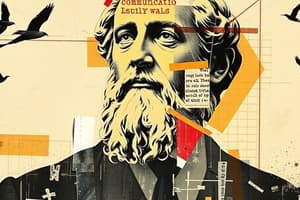Podcast
Questions and Answers
Which of these is NOT a linear model of communication?
Which of these is NOT a linear model of communication?
- Aristotle's communication model
- The Osgood-Schramm communication model (correct)
- The Shannon-Weaver communication model
- Lasswell's communication model
What direction does communication take in linear models?
What direction does communication take in linear models?
One direction
Which element is NOT mentioned as part of linear models of communication?
Which element is NOT mentioned as part of linear models of communication?
- Receiver
- Feedback (correct)
- Sender
- Channel
What are the three main elements in linear communication models?
What are the three main elements in linear communication models?
What does 'noise' refer to in communication?
What does 'noise' refer to in communication?
What is the primary focus of Aristotle's model of communication?
What is the primary focus of Aristotle's model of communication?
What are the three elements Aristotle identified to improve communication?
What are the three elements Aristotle identified to improve communication?
In Aristotle's communication model, who is considered passive?
In Aristotle's communication model, who is considered passive?
What is the drawback of Aristotle's communication model?
What is the drawback of Aristotle's communication model?
Flashcards are hidden until you start studying
Study Notes
Linear Models of Communication
- Linear communication models are one-way and often used for PR, sales, and marketing.
- They focus on the sender, the channel, and the receiver.
- They may include noise as a factor that can influence the message.
Aristotle's Model of Communication
- Developed in 300 BC.
- Focuses on the sender's effectiveness in persuading the receiver.
- The audience is passive.
- Key elements for effective communication:
- Ethos: The credibility of the speaker.
- Pathos: Emotional connection between speaker and audience.
- Logos: Logical structure and reasoning in the message.
- Main components:
- Speaker: The source of the message.
- Speech: The message delivered.
- Occasion: The context in which the communication occurs.
- Target Audience: The receivers of the message.
- Effect: The intended impact on the audience.
Lasswell's Model of Communication
- Focuses on five key elements of the communication process:
- Who?: The communicator or sender.
- Says what?: The message being sent.
- In which channel?: The medium used for communication.
- To whom?: The receiver or audience.
- With what effect?: The intended result or impact on the receiver.
- This model highlights the importance of understanding the effect the message has on the receiver.
Shannon-Weaver Model of Communication
- Focuses on the technical aspects of communication, particularly in transmitting information through electronic channels.
- It highlights the potential for noise to interfere with clear transmission.
- Key elements:
- Sender: The source of the message.
- Encoder: Translates the message into code suitable for the channel.
- Channel: The medium used for transmission.
- Decoder: Interprets the encoded message.
- Receiver: The intended recipient of the message.
- Noise: Any interference that can disrupt communication.
Berlo's S-M-C-R Model of Communication
- This model outlines a four-step process for effective message transmission:
- Sender: Refers to the communicator and includes their skills, attitudes, knowledge, and socio-cultural background.
- Message: Includes the content, structure, code, and treatment of the message itself.
- Channel: Includes the medium of communication, such as visual, auditory, or tactile.
- Receiver: Refers to the recipient of the message and includes their skills, attitudes, knowledge, and socio-cultural background.
- The key is to ensure that the sender and receiver have common ground in their communication.
Interactive Models of Communication
- These models recognize that communication is a two-way process.
Osgood-Schramm Model of Communication
- Emphasizes the importance of feedback in communication.
- The sender and receiver both decode and encode messages, creating a continuous flow of information.
- It acknowledges that both parties are simultaneously both sender and receiver.
Westley and Maclean Model of Communication
- Focuses on gatekeepers, who control the flow of information to different groups.
- The model emphasizes that communication is a complex process involving multiple stakeholders.
Transactional Models of Communication
- Highlight the dynamic and interactive nature of communication.
- Recognizes that communication is a continuous flow of messages, influence, and meaning-making.
Barnlund's Transactional Model of Communication
- Recognizes that communication is a simultaneous process of sending and receiving messages.
- The model illustrates how communication can be influenced by various factors such as cultural background, social context, and personal experiences.
Dance's Helical Model of Communication
- Emphasizes that communication is a cumulative and progressive process.
- The model compares communication to a helix, where each turn builds upon the previous one, resulting in a constantly evolving and complex exchange of messages.
- This model suggests that communication experiences shape future interactions.
Studying That Suits You
Use AI to generate personalized quizzes and flashcards to suit your learning preferences.




